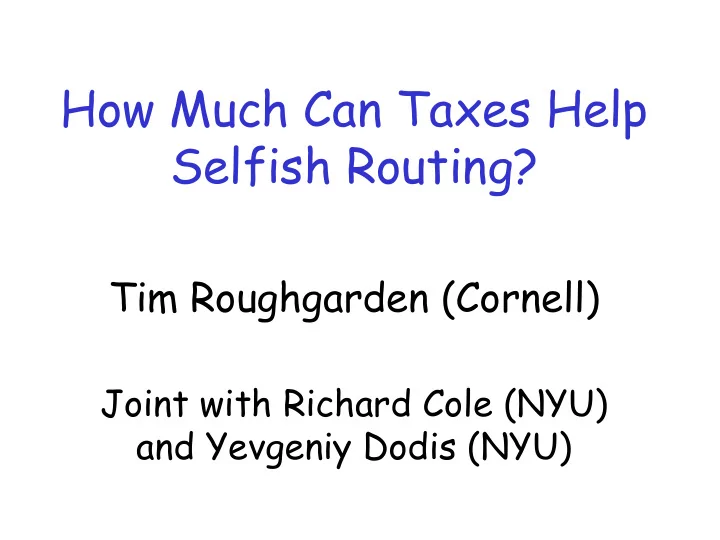

How Much Can Taxes Help Selfish Routing? Tim Roughgarden (Cornell) Joint with Richard Cole (NYU) and Yevgeniy Dodis (NYU)
Selfish Routing • a directed graph G = (V,E) • a source s and a destination t • one unit of traffic from s to t • for each edge e, a latency function ℓ e (•) – assumed continuous, nondecreasing Example: ℓ (x)=x Flow = ½ s t ℓ (x)=1 Flow = ½ 2
Routings of Traffic Traffic and Flows: • f P = fraction of traffic routed on s-t path P • flow vector f routing of traffic s t Selfish routing: what flows arise as the routes chosen by many noncooperative agents? 3
Nash Flows Some assumptions: • agents small relative to network • want to minimize personal latency Def: A flow is at Nash equilibrium (or is a Nash flow) if all flow is routed on min-latency paths [given current edge congestion] – have existence, uniqueness [Wardrop, Beckmann et al 50s] Example: Flow = 1 Flow = .5 x x s t s t 1 1 Flow = .5 Flow = 0 4
Inefficiency of Nash Flows Our objective function: average latency • ⇒ Nash flows need not be optimal • observed informally by [Pigou 1920] x ½ 1 s t 1 ½ 0 • Average latency of Nash flow = 1•1 + 0•1 = 1 • of optimal flow = ½•½ +½•1 = ¾ 5
Braess’s Paradox Initial Network: ½ ½ x 1 s t ½ ½ x 1 Delay = 1.5 6
Braess’s Paradox Initial Network: Augmented Network: ½ ½ ½ ½ x 1 x 1 0 s t s t ½ ½ ½ ½ x x 1 1 Delay = 1.5 Now what? 7
Braess’s Paradox Initial Network: Augmented Network: ½ ½ x x 1 1 s 0 t s t ½ ½ x x 1 1 Delay = 1.5 Delay = 2 All traffic incurs more delay! [Braess 68] 8
Marginal Cost Taxes Goal: do better with taxes (one per edge) – not addressing implementation 9
Marginal Cost Taxes Goal: do better with taxes (one per edge) – not addressing implementation Assume: all traffic minimizes time + money – see STOC ’03 paper for relaxing this Def: the marginal cost tax of an edge (w.r.t. a flow) is the extra delay to existing traffic caused by a marginal increase in traffic 10
Marginal Cost Taxes Goal: do better with taxes (one per edge) – not addressing implementation Assume: all traffic minimizes time + money – see STOC ’03 paper for relaxing this Def: the marginal cost tax of an edge (w.r.t. a flow) is the extra delay to existing traffic caused by a marginal increase in traffic Thm: [folklore] m arginal cost taxes w.r.t. the opt flow induce the opt flow as a Nash eq. 11
Are Taxes a Social Loss? • Problem with MCT: min delay is holy grail; exorbitant taxes ignored s t 12
Are Taxes a Social Loss? • Problem with MCT: min delay is holy grail; exorbitant taxes ignored s t • Ever reasonable?: yes, iff taxes can be refunded (directly or indirectly) 13
Are Taxes a Social Loss? • Problem with MCT: min delay is holy grail; exorbitant taxes ignored s t • Ever reasonable?: yes, iff taxes can be refunded (directly or indirectly) • New Goal: minimize total disutility with nonrefundable taxes (delay + taxes paid) – call new objective fn the cost – marginal cost taxes now not a good idea, e.g.: – Thm: w/linear latency fns, MCT never help. 14
Taxes vs. Edge Removal Note: taxes at least as good as edge removal – can effect edge deletion with large tax – are they strictly more powerful? 15
Taxes vs. Edge Removal Note: taxes at least as good as edge removal – can effect edge deletion with large tax – are they strictly more powerful? Thm: taxes can improve cost by a factor of n/2 (n = |V|), but no more. – same for edge removal [Roughgarden FOCS ‘01] – also same as edge removal for restricted classes of latency fns 16
Taxes vs. Edge Removal Question: taxes no better than edge removal in best case, how about in specific networks? 17
Taxes vs. Edge Removal Question: taxes no better than edge removal in best case, how about in specific networks? Thm: • (a) taxes can improve the Nash flow cost by an n/2 factor more than edge removal – uses step function-like latency fns – variation of Braess graphs from [Roughgarden FOCS ’01] • (b) taxes are never more powerful than edge removal in networks w/linear latency fns 18
Taxes vs. Edge Removal General Latency Fns Linear Latency Fns Nash cost Nash cost after taxes after taxes ≥ n/2 0 Nash cost after Nash cost after ≤ n/2 ≤ 4/3 edge removal edge removal ≥ n/2 ≥ 4/3 original original Nash cost Nash cost 19
Proof Sketch for Linear Case • First: assume false, look at minimal counterexample. • Look at counterexample tax on this network that minimizes cost and has smallest sum. – Technical Lemma: this minimum exists (use minimality). • Understand how Nash flow changes under local perturbations of the tax (minimality, linearity). • Perturbing to a smaller tax must increase cost. • Opposite perturbation lowers cost (contradiction). 20
Taxes Are Powerful but Elusive Recall: taxes can improve cost by a factor of n/2 (n = |V|), but no more. – powerful, but can we compute them? Thm: optimal taxes NP-hard to approximate within factor of o(n/log n). – complexity casts doubt on potential for taxes that minimize cost – based on [Roughgarden FOCS ’01] 21
Some Future Directions • Improve model – convergence issues, imperfect info – other notions of incentive-compatibility • e.g., robust to malicious users – other objective fns • Better results in this model – multicommodity flow networks 22
Recommend
More recommend